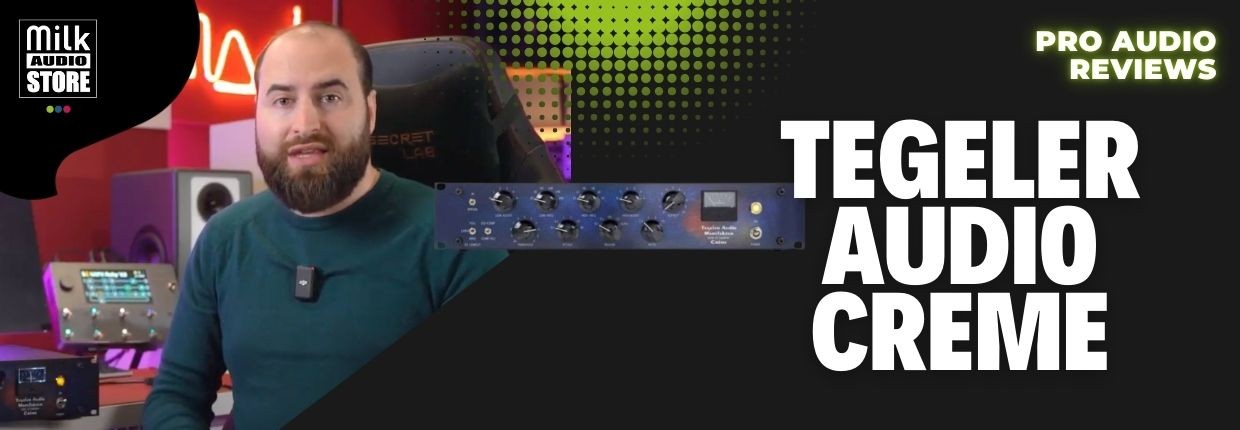Recording, Mixing and Mastering
Published on 16/10/2024

Today we present the Cream from Tegeler Audio Manufaktur. The Cream is a dual machine because we have both a compressor and an equalizer.
The compressor is a VCA-type compressor, so it is very fast. We have threshold, attack, release and ratio controls.
The ratio goes from 1.5 up to 10, so it's a compressor that can be used both in mastering, because obviously it's a VCA stereo mold machine, also great if you want to maybe control transients.
But it's a machine that can be used in any bus, even mono sources such as vocals.
On the top, however, we have theequalizer. There is the low band, the low shelf, and the high shelf high band. We have 1.5 indicators that indicate precisely the boost, where 1.5 indicates decibels, so from 1/10 up to 5 decibels of boost.
As always it is great to have sidechain to avoid going to compress on the low frequencies, at 60 Hz or 120 Hz, or full to go to compress on the whole frequency spectrum. Then there is the gain reduction indication with this VU meter that is very reminiscent of a VU meter on an SSL, so always a VCA compressor.
The bypass is general of the machine, we don't have a bypass just for the compressor or just for the equalizer.
If we want to bypass the compressor, of course we have to go and play with the threshold, so bring the threshold to zero. But that will obviously change the output volume that we can generate with the output, we don't have a volume attenuation, we just have a volume boost precisely.
So it's a little bit difficult to go match on and off with the bypass if we just want to bypass the compressor or just the equalizer. If we use the machine all together instead, obviously it is possible to do the match.
Before I tell you about the audio tests performed, I want to tell you about the behavior of this equalizer. The equalizer is very smooth, in fact it is more of a mastering equalizer. With the low shelf we can go from 20 Hz up to 200 Hz and boost the maximum 5 dB, however, the curve that is created is a very wide curve and very soft.
In fact, if we go to the minimum and boost to the maximum, we are actually boosting yes 5 dB on 20 Hz, but in fact the curve already starts from the midrange, so a very soft curve that actually also goes to affect the midrange. So be careful how you go about using it!
Obviously if we go to move up to 200 Hz, the curve is very wide and we go to boost the midrangeas well .
On the other hand, as far as the high frequencies areconcerned , the machine, already bypassed by itself, eats up some of the high frequencies.
n fact, we see from the spectrum analyzer that we have a high-frequency cut. This cut is even more emphasized when we go to set the machine to ON, so we go to turn the bypass off.
The high frequencies are then cut off, and even though we go to act with this high shelf, it is actually not really a high shelf, because we have an EQ that comes across as kind of a bump on the very high frequencies. But precisely with this low cut it is a little bit limited the machine to create this brightness on the very high frequencies
The machine actually goes up to 24 kHz, so yes, it's true, we go to boost maximum 5 dB at 24 kHz, but actually we have this cut on the very high frequencies that doesn't allow us to create a high shelf on the very high frequencies.
Let's go now to talk about how the machine behaves in masteringmode .
The bass is very soft and because the curve is very wide: be careful how you go to dose the bass because it goes to flood it a little bit if the frequencies are too high.
As far as the high shelf is concerned I feel it lacks a little bit of brightness because there is this cut off on the very high frequencies.
Obviously the VCA-style compressor works great and is great. We also have this switch to change the position between equalizer and compressor.
I also did a test with the equalizer before the compressor, which I don't like so much personally, I prefer to use the compressor first, because the compressor usually goes and eats some low frequencies, even if we use sidechain.
Also, I like to restore the low frequencies, so having my equalization right after the compressor. Of course, this is a stylistic choice; it's a mix engineer's choice, if you like to have the compressor before or after you can do that.
We listened to the behavior of the machine with a mono source, so for example vocals, but also with a stereo source, for example drums, both in the bass drum and just on the room. I really like to use VCA compressors on the room to get thatsquash effect.
Drawing conclusions, a very interesting machine indeed. Fantastic compressor, fast and versatile for both mono and stereo sources and mastering. It is a very smooth equalizer, sometimes a little too smooth.
The high band I would have preferred not to have this preponderant cut because it does not allow me to use a high shelf, but it becomes a bump.
As always, if you want to personally get your hands on the Tegeler Cream, I invite you to visit the Milk Audio Store showroom.
Join us today and get 5% off your next order!

Empty cart